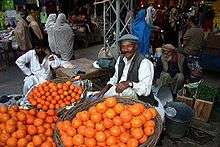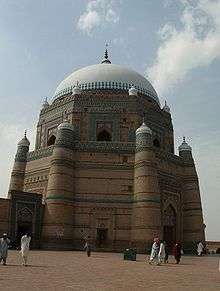Saraiki culture

Saraiki culture is the culture of the Saraiki people, residing in Pakistan and outside Pakistan.
Religion

Almost 99% population in Saraikistan region is Muslim. Islam came to this region with the Arab conquest of Sindh in eighth century. Majority of Muslims are Sunnis while Shia population is also in considerable size. The region is home to many Sufism. There is a saying in Persian that Multan is the 'city of dust (because of its sandy climate), summer, beggars and graveyards' (Gard, Garma, Gada o Goristan).[1] It is also called as the city of saints (madinatul Auliya مدینۃالاولیا). The city has been a focal point for many religions, in particular becoming a central abode for Sufism, the mystical side of Islam. The city has attracted Sufi saints from far places of the globe. One of the first Sufi saints to arrive in Multan was Hazrat Shah Gardez who is considered as the founder of Muslim Multan according to a BBC world documentary. Multan has been the centre of Suhrawardiyya, one of the major Sufi orders, called as Tariqa. It has the shrines of Hazrat Baha-ud-din Zakariya and Hazrat Shah Rukn-e-Alam.
Similarly, Uch Sharif has been the centre of Qadiriyya Sufi order. Allama Iqbal while referring to the two great Sufi saints of Saraiki region, Khwaja Ghulam Farid and Muhammad Suleman Taunsvi, said that this region can not be empty from spirituality. The tomb of Sakhi Sarwar in Dera Ghazi Khan is also very popular shrine in Pakistan.
Saraiki literature
Saraiki language
It was only in 2009 that when Dr Javaid Laghari, a saraiki speaking Chairman of the Higher Education Commission of Pakistan, commissioned research on and the publication of the Saraiki Dictionary
Poetry
Since the name of the Seraiki came into being after the creation of Pakistan, so much of the literature in this language is pretty recent. Seraiki language was standardized in the 1960s so no written Seraiki literature existed before that. The recent Saraiki is famous for its Sufi poetry.
Shakir Shujabadi (Kalam-e-Shakir, Khuda Janey, Shakir Diyan Ghazlan, Peelay Patr, Munafqan Tu Khuda Bachaway, Shakir De Dohray are his famous books) is very well recognized modern poet.[2] Jaanbaz Jatoi has been a famous poet and has left a poetical book after his name. Kausar Jatoi and Shedu are famous poets of Jhuggi Wala (Tehsil Jatoi).
Saraiki folklore
Saraiki area is spread from Jand to Morro. It is rich in folklore. Kausar Japani performs singing during privately arranged parties on a cost mutually agreed by both the parties.She is becoming very famous among youngsters fond of music.
Saraiki singers
List of Saraiki Singres and their MP3 Songs [3] More than a thousand Saraiki singers are performing in Saraiki Mushaira (TP), Best of Saraiki and Punjabi Eid Gift 2012, Radio and Television,[4][5][6]
Some of these are:
- Abida Parveen
- Afshan Zebi
- Ahmad Khan Malangi
- Ahmad Nawaz Cheena
- Ajmal Sajid
- Akram Rahi
- Allah Ditta Loney Wala
- Allah Ditta Panchi
- Amjad Nawaz Karloo
- Anmol Sayal
- Asad abbas multani
- Ashraf Litti
- Ashraf Mirza
- Attaullah and Heem Lata
- Attaullah Khan Esakhelvi
- Azhar Abbas Khushabi
- Babar Niazi - Javed Niazi
- Bashir Ahmad Mukhlis
- Bushra sadiq
- Chan sharmila
- Ejaz Rahi
- Farah Laal
- Gul Tari Khelvi
- Haseena Mumtaz
- Hamid Jamshed
- Humera Channa
- Hussain Bandyalvi
- Imran niazi
- Iqbal Hussain Pappu
- Irshad Hussain Tedi
- Jaspinder Narula
- Jumman Khan
- Komal Noor
- Kosar Japani
- Lal pari
- Malkoo
- Mansoor Malangi
- Manzoor hussain tharaj
- Mastana Parwana
- Miss Badro Multani
- Nadeem Abbas
- Naeem Hazara
- Naseebo Laal
- Nazakat Ali Papu
- Nooran Laal
- Pathanay Khan
- Rashid Ali Warburtun
- Riaz Mahi
- Rohan Abbas
- Rukhsana Hazara
- Sain Zahoor
- Sajid Ali Khan Multani
- Saleem Akhtar Saleemi
- Sanam Afreen
- Shabnam Majeed
- Shafaullah Khan Rokhri
- Shafqat Abbas Shafqat
- Shahid Abbas Shehdi
- Shazia Khushk
- Shahzia Naaz
- Shahzia Rani
- Shakeel Awan
- Sharafat Ali Tari Khelvi
- Shehnaz Pakistani
- Shehzada Asif Ali
- Shehzadi Irum Sayal
- Shoukat Ali Raja
- Sunbul Raja
- Sunny Iqbal
- Sorayya Multanikar
- Tahir Mehmood Nayyar
- Taj Multani
- Talib Hussain Dard
- Taslim Shehzadi
- Wajid Ali Baghdadi
- Yasir Khan Moosa Khelvi
- Zahoor Mirza
- Zain Ali
- Zahida Parveen
- Zulfiqar zulfi
- Abida Parveen
- Attaullah, Isa Khelvi
- Mansoor Malangi
- Nadeem Abbas
- Shazia Khushk
- Talib Hussain Dard
- nadeem lonay wala
Clothing
People usually wear Shalwar kameez, which is the national dress of Pakistan. The traditional male dress is Lungi with Chola (kameez).The tradition male dresses suthanr shalwar, Ghayiroli Saraiki Shalwar Suthanr Shalwar,The tradition put Rumal or Pashmina or Shaal on shoulder .Shalwar with Kamez. Chadar is also an important part of male and female dress. Women wear bochanrr, Chunni (Chunri)and men wear Patka on the head. Women also used to wear ghagra but it is not used only for wedding and parties. Ajrak and Topi is also worn by people. Saraiki men also like to have moustaches locally saying (muchaan), and little beard and the dressing of the hairs(waal) are short cutted . Somewhere these are long cutted by the own desire of them.
Cuisine
Flowers of Sohanjrraan or Sohanjna (Moringa oleifera) is one of the most famous vegetable dish in South Punjab. Sohan Halwa is traditional sweet made by boiling a mixture of water, sugar, milk and cornflour until it becomes solid.
Traditional sports
Deeti Danna (Saraiki: ݙیٹی ݙنا)is one of the famous traditional sports especially for boys in rural areas along with other sports like Baandar Killa [باندر کلّا], Pittu Garam [پٹّو گرم], Stapu [سٹاپو] and Kabaddi [کبڈی], Datthi Ghori, Assu Panju etc.
Art and music
Jhumar
Jhumar or Jhoomar is the traditional Saraiki folk dance. It is a lively form of music and dance that originated in the Multan and Balochistan. It is slow and rhythmic. The word "Jhumar" comes from jhum/jhoom, which means swaying. The songs evoke a quality reminiscent of swaying. The content of these songs is varied; they are usually love with emotional songs, too. The Jhumar is a dance of ecstasy. Jhumar is performed usually at the wedding ceremonies. It is a living demonstration of the happiness. The dance is mostly performed by the Balochi and Saraiki people of Southern Punjab. The emphasis of Jhumar is recreating the gaits of animals and birds. The movement of animals, the ploughing of the field, sowing of seeds and harvesting are shown in the original progression. The dance is also performed in circle, to the tune of emotional songs. Another Saraiki dance is Poochhra which is performed mostly on weddings. One woman holds back hanging part of Kameez of another woman and that second woman dances by jumping to right and left. Performed exclusively by men, it is a common feature to see three generations — father, son and grandson — dancing together at weddings. The dance is without acrobatics. Each region of Southern Punjab has its own variation of Jhumar. The movement of the arms only is considered its main forte. Feet are musically placed in front and backwards, and turns are taken to the right. Sometimes the dancers place one hand below the ribs on the left and gesticulate with the right hand. This dance does not tire out its performers, and it is normally danced on moonlight nights in the villages away from the habitation. The dancers let-off a sound, "Dee Dee," in tune with the beat of the dance which adds to its grace.
Saraiki music
Charpai and Hamacha
In the city there is Charpai, locally known as khatt کھٹ and Hamacha culture ماچا. Charpai and Hamacha means a big heavy wooden bed wooven with wanr ((ropes) made of date-tree leaves or Koondr long leaves), which are kepts at Chowks and Baithaks. You can find these Hamachas in every chowks, baithaks and wisakh.
Normally people sit on charpai and hamacha in the evening and on holidays. There they discuss their daily personal, social and political issues in friendly environment. The biggest charpai of the world is in Dera Ghazi Khan according to Guinness World Records.
See also
- "Saraikistan"
- List of Seraiki tribes
- Indus Valley Civilization